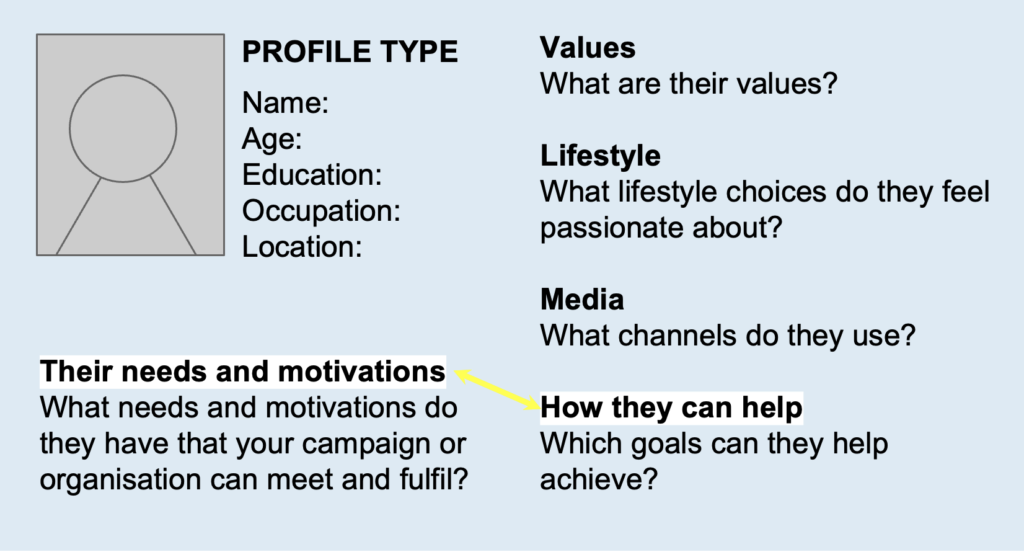Identifying the people you need to engage and understanding their hopes, fears, goals and motivations.
This is the 5-step process you’ll need to go through to identify and understand your audience groups.
Step 1: Strategise
Thinking about the people you want to reach is like putting your team together. Who do you need for your change to happen?
You’ve already started thinking about this in the ‘Purpose‘ section when conducting the power analysis and developing a theory of change. Now expand on this to create a ‘long list’. Make it as long as you can, aiming to understand everyone who is likely to have any kind of relationship to this issue. Think about the type of people who are likely to become your activists, supporters, beneficiaries, influencers and decision-makers.
Step 2: Segment
Audience segmentation is the process by which you identify audience groups by factors they have in common. There are many ways to segment, though they generally fall into ‘demographic’ or ‘psychographic’ approaches.
Demographics
Gender, age, occupation, location, income, education, ethnicity and family situation are all demographics. Campaigners often make the mistake of thinking about audience mostly in demographics: “Our campaign needs to target women in Wales between the ages of 18 and 35.”
But people don’t make decisions based on their gender, age or occupation. There could be a lot of people with these characteristics but they’re making very different decisions. Demographics can be useful to help us understand how someone is more or less likely to think in certain ways, but it’s how people feel that drives the decisions about what they might do.
Psychographics
How people think and feel is their ‘psychographic’ makeup. A psychographic segmentation identifies a group by any of the activities, interests, opinions, needs, motivations or values they have in common.
Allies, enemies and neutrals
For many cause campaigns, the most useful approach to segmentation is considering how different people relate to your cause. The ‘spectrum of allies’ tool is a powerful tool to help identify target audiences and understand whether they are likely to become your allies. It can also help you plan how to move those neutral to your cause to become allies, and how to convert passive allies into active ones.
Step 3: Prioritise
You can’t engage with ‘everyone’ in a meaningful way. Your communications need to be tailored to resonate with the people you most need to work with. So having drawn up a long list of all the types of people related to your campaign, now identify the priority audience groups. These are where all your communications will focus.
Between three and six is a useful number of groups. More than this and you’ll struggle to achieve the engagement you need to inspire them to action. Less than this and you might not be segmenting with enough detail to be really helpful.
Step 4: Research
If you’re using a largely psychographic approach to identify priority audiences, you’re already starting to understand them. But now you need to find out as much as you can.
If creating a strategy for an existing campaign or organisation, start with analysing existing data from website analytics, social media insights and your own databases.
You can use publicly available data such as that published by Ofcom, Office for National Statistics and UK Government statistics.
Use the Facebook Ad Centre to compare and quantify activities and interests between different demographics and locations. There’s no need to publish or pay for any ads, just starting to create an ad will allow you to explore some very rich data.
Once you’ve started to identify the brands your target audiences are likely to be engaging with, you can follow this trail to find more data and insight. For media brands, their media pack for advertisers will have a lot of detail about their audience and reach.
YouGov has details about many brands, charities and organisations – research your competitors here and find out about their supporters.
All of this is freely available public data, but conducting your own audience research is likely to offer the most useful and focused insights. Surveys can be useful, but nothing beats actually talking to people, either in one-to-one interviews or focus groups.
Step 5: Profile
Audience work is about identifying and understanding GROUPS. But the best communication is one-to-one, so your communications need to feel like you’re talking to an individual not broadcasting to a group. So the final stage is creating personas as fictionalised representations of each of your audience groups.
A persona profile pulls all this information together into an easily scanned format. Once you’ve created these personas profiles, get to know them. Give them a name, relate to them as you would a friend. And every time you produce communications that need to engage this group, think of it as talking directly to this person.
Below is a template for a typical persona profile. Notice how this is mostly psychographic information, and also includes how your campaign can help them achieve their goals.

Reading and resources




- Make it Matter, Barrell, J (2014). Knowing your audiences: p53-77
- What Makes People Tick, Rose, C (2011)
- Winning the Story Wars, Sachs, J (2012). Chapter 5: Maslow’s Answer to Freud: a Foundation for Empowerment Marketing
